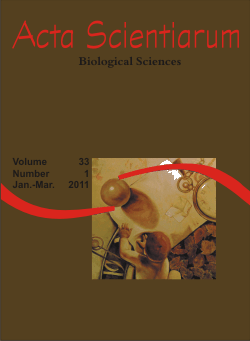<b>Abordagem fitoquímica, composição bromatológica e atividade antibacteriana de <em>Mimosa tenuiflora</em> (Wild) Poiret E <em>Piptadenia stipulacea</em> (Benth) Ducke</b> - doi: 10.4025/actascibiolsci.v33i1.5366
Resumo
A necessidade de encontrar novas drogas eficazes no combate microbiano tem aumentado a cada dia e estimulado a busca de novos compostos naturais com atividades biológicas. Neste trabalho, realizaram-se estudo fitoquímico e análises microbiológicas com os extratos etanólicos das espécies (jurema-preta) Mimosa tenuiflora (Wild) Poiret e (jurema-branca) Piptadenia stipulacea (Benth) Ducke, frente a linhagens de bactérias patogênicas. O pó da casca do caule de ambas as espécies foi submetido à avaliação bromatológica e determinados os teores de Matéria Seca, Matéria Mineral, Proteína Bruta, Fibra em Detergente Neutro e Energia Bruta. Os resultados para a prospecção química indicaram a presença de taninos e outros compostos fenólicos, bem como a presença de saponinas em ambos os extratos. Os extratos das duas espécies demonstraram que mais de uma parte das plantas possui atividade antimicrobiana. A composição bromatológica da casca do caule de jurema-preta e jurema-branca apresentou teores diferenciados para as variáveis avaliadas.Downloads
DECLARAÇÃO DE ORIGINALIDADE E DIREITOS AUTORAIS
Declaro que o presente artigo é original, não tendo sido submetido à publicação em qualquer outro periódico nacional ou internacional, quer seja em parte ou em sua totalidade.
Os direitos autorais pertencem exclusivamente aos autores. Os direitos de licenciamento utilizados pelo periódico é a licença Creative Commons Attribution 4.0 (CC BY 4.0): são permitidos o compartilhamento (cópia e distribuição do material em qualqer meio ou formato) e adaptação (remix, transformação e criação de material a partir do conteúdo assim licenciado para quaisquer fins, inclusive comerciais.
Recomenda-se a leitura desse link para maiores informações sobre o tema: fornecimento de créditos e referências de forma correta, entre outros detalhes cruciais para uso adequado do material licenciado.












1.png)




3.png)













